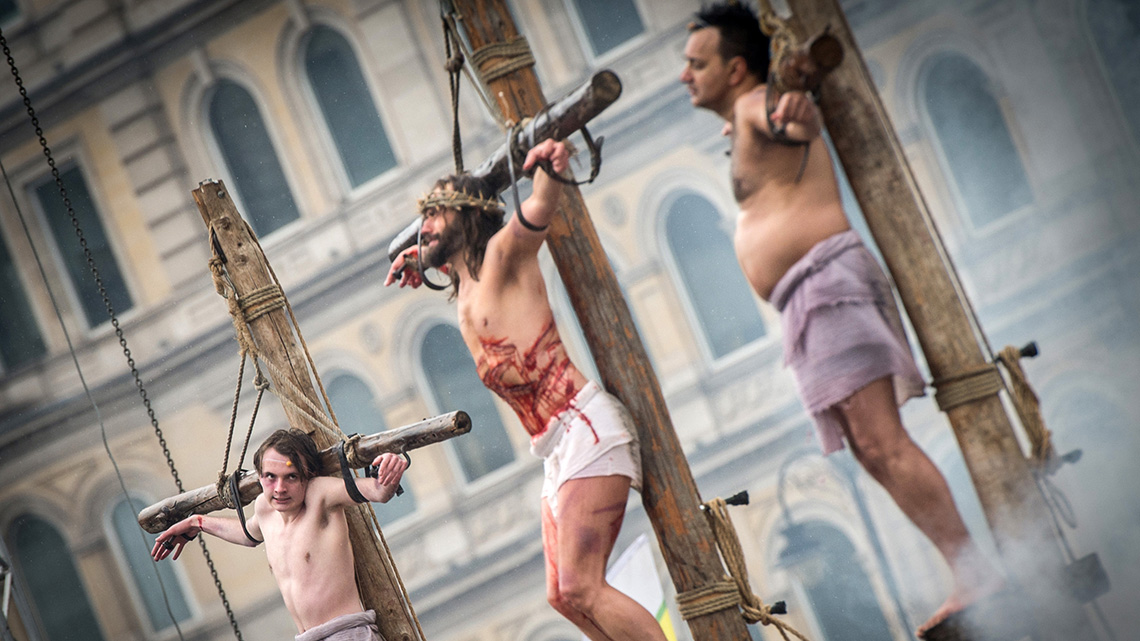On Good Friday we celebrate the Passion and Death of our Lord Jesus Christ as a redemption for the whole human race.

According to the Gospel accounts, the Royal Guard arrested Jesus in the Garden of Gethsemane after Judas Iscariot had told the guards that whomever he kissed was the one they were to arrest. Following his arrest, Jesus was taken to the house of Annas, the father-in-law of the high priest, Caiaphas.
There he was interrogated with little result and sent bound to Caiaphas the high priest where the Sanhedrin had assembled (Jn 18:1–24). Conflicting testimony against Jesus was brought forth by many witnesses, to which Jesus answered nothing. The high priest condemned Jesus for blasphemy, and the Sanhedrin concurred with a sentence of death (Mt 26:57–66).
He was sent to the Roman governor Pontius Pilate under charges of subverting the nation, opposing taxes to Caesar, and making himself a king (Lk 23:1–2).
Pilate authorized the Jewish leaders to judge Jesus according to their own law and execute sentencing; however, the Jewish leaders replied that they were not allowed by the Romans to carry out a sentence of death (Jn 18:31). Pilate referred the case to the ruler of Galilee, King Herod, who was in Jerusalem for the Passover Feast.
Herod questioned Jesus but received no answer, so sent Jesus back to Pilate. Pilate found Jesus innocent, but sent him to be flogged and released. Under the guidance of the chief priests, the people demanded that Jesus be crucified “because he claimed to be God’s son.” (Mk 15:6–14).
Out of fear, Pilate handed Jesus over to be crucified in order to forestall a riot. Jesus carried his cross to the site of execution called the “place of the Skull”, or “Golgotha” in Hebrew and in Latin “Calvary”. There he was crucified along with two criminals, the sentence written was “Jesus of Nazareth, King of the Jews.”.
Jesus agonized on the cross for six hours. During his last three hours on the cross, from noon to 3 pm, darkness fell over the whole land. Jesus spoke from the cross, quoting the messianic Psalm 22: “My God, my God, why have you forsaken me?” With a loud cry, Jesus gave up his spirit and died on the Cross.
There was an earthquake, tombs broke open, and the curtain in the Temple was torn from top to bottom. The centurion on guard at the site of crucifixion declared, “Truly this was God’s Son” (Mt 27:45–54).
On this day, and the Saturday of Holy Week, the Church does not celebrate the Sacraments at all, except for Penance and the Anointing of the Sick.
Cardinal Vincent Nichols invites us to follow him through the stations of the Cross. We use the traditional text from Saint Alphonsus Liguori. As the Cardinal says: “It’s written from the heart and it speaks to our hearts.”
On this Good Friday, we have the second in our four-part art and culture series ‘The Art of Holy Week’. We take a close look at ‘Christ Crucified’ painted by Diego Velázquez in 1632.